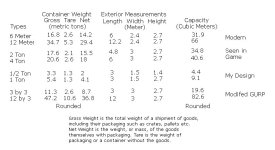@aramis This is what I came up with using the Gurp info gain from @Tjonesio.

I'm not going to go into all the math I did to come up with these figures. I just going to give you an overview.
The designer at GURP decide 445 kg was a good number for determining the weight of the container by cubic meters.
I subtract .2m from the Exterior Measurements to get the Capacity because this was the difference I saw in real world container.
The weight of the container is 445 kg times the length, doubled if the container is wider than 2.4 meters.
I settled on 2.7 because it allow something like a pallet jack/forklift to get under the container and still have room for lighting without raising the deck.
Modern: Based on Modern Cargo Containers.
Seen in Game: Up until this post, these were the two common type containers on deckplans.
My Design: I'm not sure about the 1 Ton Container being my design but I'm sure 1/2 ton is. It allow you two stack to containers in one space without raising the ceiling.
Modified GURP: I subtracted .3 from the height.
I rounded all numbers to the closest decimal one place out?

